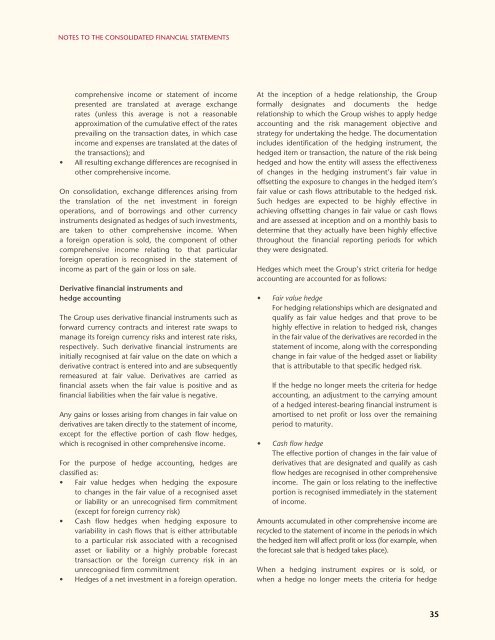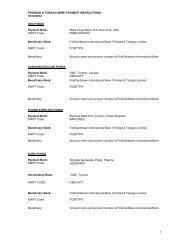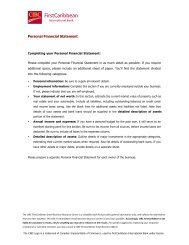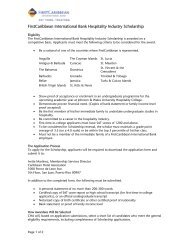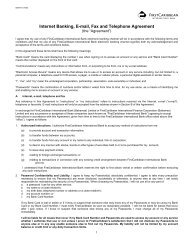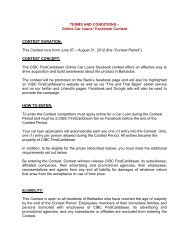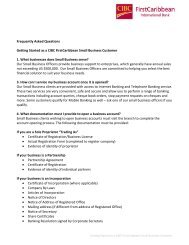FirstCaribbean International Bank Limited
FirstCaribbean International Bank Limited
FirstCaribbean International Bank Limited
Create successful ePaper yourself
Turn your PDF publications into a flip-book with our unique Google optimized e-Paper software.
Notes To The Consolidated Financial Statements<br />
comprehensive income or statement of income<br />
presented are translated at average exchange<br />
rates (unless this average is not a reasonable<br />
approximation of the cumulative effect of the rates<br />
prevailing on the transaction dates, in which case<br />
income and expenses are translated at the dates of<br />
the transactions); and<br />
• All resulting exchange differences are recognised in<br />
other comprehensive income.<br />
On consolidation, exchange differences arising from<br />
the translation of the net investment in foreign<br />
operations, and of borrowings and other currency<br />
instruments designated as hedges of such investments,<br />
are taken to other comprehensive income. When<br />
a foreign operation is sold, the component of other<br />
comprehensive income relating to that particular<br />
foreign operation is recognised in the statement of<br />
income as part of the gain or loss on sale.<br />
Derivative financial instruments and<br />
hedge accounting<br />
The Group uses derivative financial instruments such as<br />
forward currency contracts and interest rate swaps to<br />
manage its foreign currency risks and interest rate risks,<br />
respectively. Such derivative financial instruments are<br />
initially recognised at fair value on the date on which a<br />
derivative contract is entered into and are subsequently<br />
remeasured at fair value. Derivatives are carried as<br />
financial assets when the fair value is positive and as<br />
financial liabilities when the fair value is negative.<br />
Any gains or losses arising from changes in fair value on<br />
derivatives are taken directly to the statement of income,<br />
except for the effective portion of cash flow hedges,<br />
which is recognised in other comprehensive income.<br />
For the purpose of hedge accounting, hedges are<br />
classified as:<br />
• Fair value hedges when hedging the exposure<br />
to changes in the fair value of a recognised asset<br />
or liability or an unrecognised firm commitment<br />
(except for foreign currency risk)<br />
• Cash flow hedges when hedging exposure to<br />
variability in cash flows that is either attributable<br />
to a particular risk associated with a recognised<br />
asset or liability or a highly probable forecast<br />
transaction or the foreign currency risk in an<br />
unrecognised firm commitment<br />
• Hedges of a net investment in a foreign operation.<br />
At the inception of a hedge relationship, the Group<br />
formally designates and documents the hedge<br />
relationship to which the Group wishes to apply hedge<br />
accounting and the risk management objective and<br />
strategy for undertaking the hedge. The documentation<br />
includes identification of the hedging instrument, the<br />
hedged item or transaction, the nature of the risk being<br />
hedged and how the entity will assess the effectiveness<br />
of changes in the hedging instrument’s fair value in<br />
offsetting the exposure to changes in the hedged item’s<br />
fair value or cash flows attributable to the hedged risk.<br />
Such hedges are expected to be highly effective in<br />
achieving offsetting changes in fair value or cash flows<br />
and are assessed at inception and on a monthly basis to<br />
determine that they actually have been highly effective<br />
throughout the financial reporting periods for which<br />
they were designated.<br />
Hedges which meet the Group’s strict criteria for hedge<br />
accounting are accounted for as follows:<br />
• Fair value hedge<br />
For hedging relationships which are designated and<br />
qualify as fair value hedges and that prove to be<br />
highly effective in relation to hedged risk, changes<br />
in the fair value of the derivatives are recorded in the<br />
statement of income, along with the corresponding<br />
change in fair value of the hedged asset or liability<br />
that is attributable to that specific hedged risk.<br />
If the hedge no longer meets the criteria for hedge<br />
accounting, an adjustment to the carrying amount<br />
of a hedged interest-bearing financial instrument is<br />
amortised to net profit or loss over the remaining<br />
period to maturity.<br />
• Cash flow hedge<br />
The effective portion of changes in the fair value of<br />
derivatives that are designated and qualify as cash<br />
flow hedges are recognised in other comprehensive<br />
income. The gain or loss relating to the ineffective<br />
portion is recognised immediately in the statement<br />
of income.<br />
Amounts accumulated in other comprehensive income are<br />
recycled to the statement of income in the periods in which<br />
the hedged item will affect profit or loss (for example, when<br />
the forecast sale that is hedged takes place).<br />
When a hedging instrument expires or is sold, or<br />
when a hedge no longer meets the criteria for hedge<br />
35


